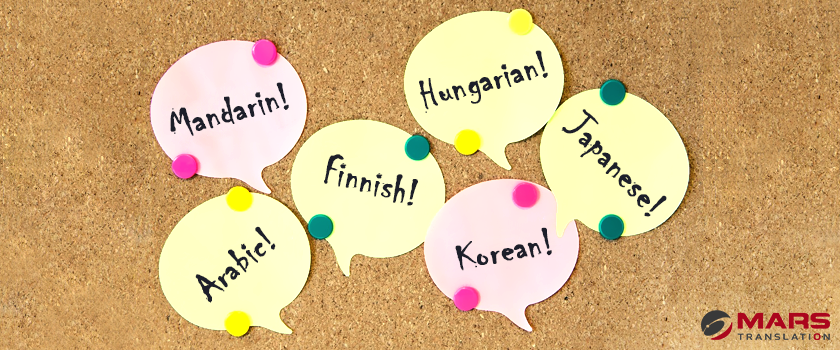8 Hardest Languages to Learn in the World
By: Ricky vela Posted on Fri, 07-09-2018

Languages act as a cornerstone for all civilizations. In this blog, we will discuss which languages are the hardest languages to learn in the world. Historically speaking, languages have played an irreplaceable role in creating civilizations and helping them develop.
One cannot talk about the impact that is left by various civilizations without talking about the native languages. Languages play a crucial role in helping us map history. And the impact of all civilizations can very easily be measured by the impact that their native tongues have.
Knowing that we will be comprehensively discussing what the hardest language to learn in the world is. Though it is not going to be easy to objectively quantify what the most difficult languages to learn in the world are. Still, we can create a pretty clear vision as to what makes certain languages difficult.
There are many reasons, which play a role in making many languages difficult. That is why it cannot be easy to calculate a definitive answer as to what is the single most difficult language. A language can be difficult depending on many different reasons.
Table of Content
What Makes a Language Difficult?
- The factors that make languages hard to learn include:
- Vocabulary
- Grammar
- Sound System
- Sentence Structures
- Dialects
- Alphabet
There are many different factors that make some languages difficult and others easy. Among these factors are Vocabulary, Dialects, and Alphabets used by the language.
Some languages have a very small set of alphabets (For Example, English) whilst others have a comparatively larger and more diverse, and non-linear set of alphabets (such as Mandarin and Arabic) Languages like English that have a smaller set of alphabets that number to 26 is easier to learn.
This, compared to other languages like Mandarin is easier. And the complex vocabulary involved with Mandarin makes it one of the most difficult languages to learn in the world.
The Role of your First Language
Other factors that play a role include things such as the diversity of different words involved in making a certain language more difficult compared to others. For example, some languages have a little amount of grammatical gender.
This is compared to some languages like Polynesian, which has different and diverse “noun classes” that are used to define a person’s gender.
Another factor that plays a major role in measuring how difficult one language is compared to another is the kind of grammatical structures that the language uses.
Languages that include Arabic and other Semitic languages have many different types of sentence structures used to define various situations making the languages difficult to learn.
What this shows is that there are many diverse languages in the world that are more difficult compared to others whilst there are some languages (including English) that have very simple and easy-to-use grammar, punctuation, and syntax.
This makes English one of the comparatively easier languages spoken among the vast number of other different languages that are spoken around the world.
Other factors that play a role in determining the difficulty of a language to learn include:
- The history of the language
- The language family that it is from
- The punctuation of the language
The Role of the Learners' First Language
The hardest language in the world differs vastly depending on the subjective nature of the language with respect to the person that is learning it. In this case, it is easier for someone to learn a language that is in the same language tree or language family as a language that they have as a mother language that they use for all different types of communications.
In case you want to learn French, it may be easier for you to learn languages such as Spanish, Italian or Portuguese whilst compared to Arabic or Hebrew.
The reason for this is that when you learn a language that belongs to the same Language tree as a language that you are already fluent in, then it will be easier to learn whilst compared to a language that is from a different language tree.
In another case, if you want to learn Urdu, then it will be very helpful for you if you already have a strong grasp of another language from the same language tree.
For Example: If you have a strong grasp of Persian or Hindi, then you will be able to learn Urdu more easily. This is because Urdu is a language that is in the same language tree as the languages that have been mentioned above.
List of Hardest Languages to Learn in the World
It can be easier to learn a language in case you can speak a language that is similar to the languages that you can already speak well and know well. Here, we have listed the hardest languages to learn.
1. Mandarin
Mandarin is a language within the Sino-Tibetan language group and is actually the most widely spoken language. For an English speaker, however, mastering Mandarin is very difficult. This is because it is a tonal language. interesting it is even difficult for the Chinese natives and therefore there is a simplified version of Chinese also exists which people prefer to use for the day to day communication.
Its writing system is extremely difficult for non-natives and English speakers and other language speakers who are familiar with the Latin alphabet. Other than Mandarin is a tonal language it's writing of Chinese characters is also difficult for non-natives to pick up and learn.
2. Arabic
In Arabic, a lot of the letters are written in many different forms depending on where it is put in a word, and to make things more complicated, vowels are not a part of the writing. This makes translating a lot more difficult when done into Arabic compared to most other languages. It is also written from right to left unlike European languages, Arabic is one of the top five spoken languages of the world, however quite tough for English speakers to learn.
Also, Arabic has many varying dialects, which means that the Arabic spoken by people in Syria is very different from the one spoken in Saudi Arabia and it has a different version and vocabulary in the middle east.
3. Finnish
Finnish is a Uralic language that comes from the Finnic branch and it is one of the official languages of Finland with Swedish. Finnish is considered one of the difficult languages to learn. It is particularly difficult for English speakers and for Estonians on the other hand it is quite familiar and easier to understand as both languages come from the same language family.
The Finnish language is a lot different from the other common languages in practice such as English. It doesn’t have a lot of prepositions, unlike English. Rather there are fifteen noun cases that are in use in the Finnish language for expressing the same things which are used as prepositions. Fifteen noun cases are indeed a lot for non-natives. Similarly, 150 prepositions could be a lot for the Finnish language.
4. Hungarian
Hungarian is another Uralic language that is spoken in Hungary mainly and also has its speakers in the neighboring countries. It is the official language of Hungary and one of the 24 official languages of the European Union.
Hungarian is also one of the hardest languages to learn. It is a difficult language with the perspective of the sounds and trains of thought that English speakers are unaware of. There is also a clash of speech patterns remarkably. Hungarian is an agglutinative language and it uses a number of affixes mainly suffixes though but also some prefixes and circumfixes. These play their role to change a word’s meaning and grammatical function. The nouns of Hungarian are 18 and these are formed with regular suffixes.
5. Korean
Korean is the national and official language of North and South Korea. The Korean language was considered to be an isolated language due to its non-attachment with any other language. Moreover, it has its own language family and there is no other language that shares the hierarchy. The Korean language is difficult and different as well due to the fact that it never had any distinct relative or feature to other languages.
The Korean language is quite tough and difficult to learn for a non-native. Korean script is written in Hangul which is in South Korea and it is Chosŏn'gŭl for North Korea. There are 24 basic letters and 27 complex letters which have been formed from the basic ones. Korean, interestingly used to be a spoken language for a long without any writing system and pattern. One main thing that makes Korean hard to learn is the verb ending forms depending on the context.
6. Japanese
Japanese is an official language of Japan and also a national language of the country. It belongs to the Japonic or Japanese-Ryukyuan family of languages. Japanese is also a tough language. It is an agglutinative language. It has a pure vowel system, a phonemic vowel, and consonant length. It is also a lexically significant pitch accent. Japan was an oral language and had no designated writing system for long. Literacy in Japan was then introduced in the form of the Chinese writing system. Japanese first used to write in the Chinese writing system.
US foreign services institutes rank it as the most difficult language for native English speakers to learn. They have determined that 88 weeks for the hardest language to learn and the same goes for the Japanese language.
7. Basque
Basque is a language that belongs to Basques and other parts of the Basque country. This region straddles the adjacent parts of northern Spain and southwestern France. Basque is an isolated language linguistically. It is the only surviving language in Europe. It is another agglutinative morphology. Latin script is used for the Basque alphabet. It has borrowed the 40% of its vocabulary from the Romance languages.
There are hardly any institutes offering courses in this language as it is one of the extremely tough languages to learn for non-natives. It has a lot of verbs. However, it is interesting to note that it is by no means similar to any language but its accent somehow shares the things with a Spanish accent.
8. Vietnamese
The Vietnamese language comes from Vietnam. It is a tonal language with 6 tones and is commonly spoken in Vietnam and Southern China. It uses the Latin alphabet with a twist. It is a really hard language to learn particularly for English speakers and learning tonal languages for English speakers is a real challenge.
This language also uses more vowels as compared to the English language and has many different dialects too. Its dialects are mutually intelligible which makes it even tough to learn and understand soon.
Final words
There are thousands of languages that are spoken all over the globe. A lot of these are easy to learn as compared to others. Every language has its own writing system and grammar composition which determines its level of difficulty. Eight of the languages that English speakers and non-natives may face trouble learning and which are hard to learn have been shared for the guidance of the readers and avid language learners. if you want to read the more interesting blogs click here

Africa is the second largest and second most populous continent. As recent statistics suggest, 1,486,275,887 is the current population of
Read more
dxf: DXF is a CAD data file format developed by Autodesk for CAD data exchange between AutoCAD and other software. docx:
Read more
Mars Translation can help you extract the texts in a DXF file and convert them into a XML file so
Read more
Mars Translation can help you extract the texts in a DWG file and convert them into a Word file so
Read more
No state on the western side of the globe can compare the strategic geographic location, diverse multilingual workforce, and attention
Read more
San Diego is California's second-largest city, and it has a population of 1.3 million from which three million residents are
Read more
Dallas is the largest state in Texas after Houston and San Antonio. It is the ninth most populous city in
Read more
In this day and age, users love to consume video content. Statistics show that almost 90% of all internet users
Read more
Virtual reality is transforming our imaginative worlds into existence. Since childhood, we used to create visionary kingdoms and act like
Read more